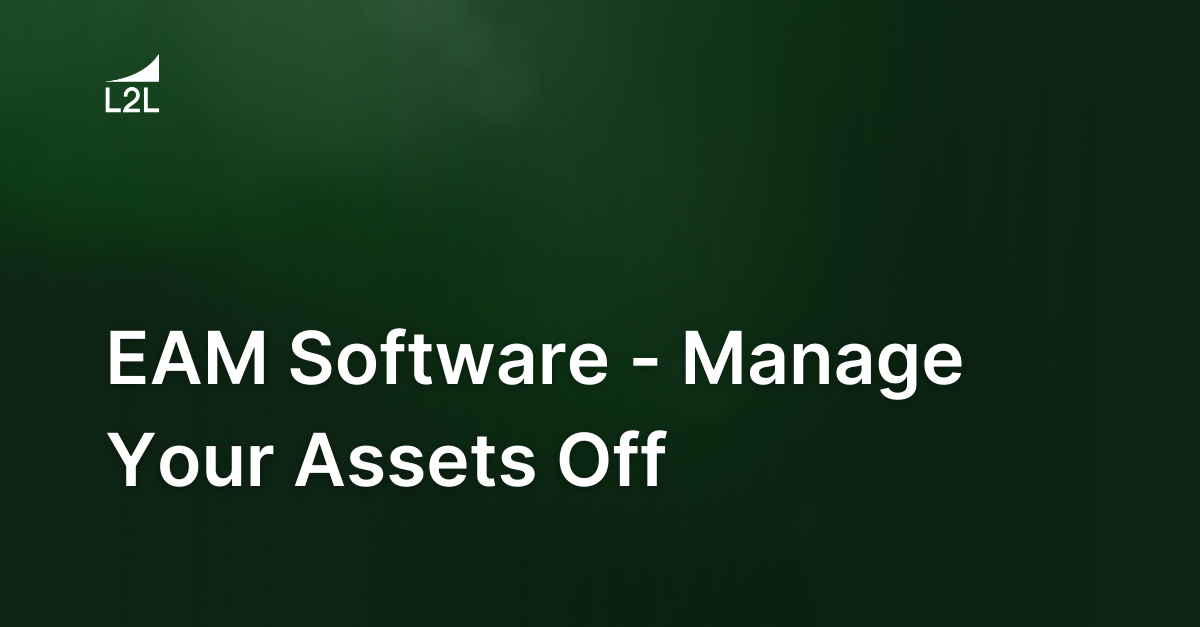
EAM Software may not be at the top of your short list of small talk, conversation starters. But when you're the person responsible for managing and reporting on your company's assets, maybe it ought to be. For starters, pun intended, asset management is everyone's business, whether they consciously realize it or not. When the buck stops with you, you'd better believe it's your business.
Enterprise Asset Management, more commonly called by its familiar acronym EAM, is a vital component in measuring and ensuring the viability and profitability of nearly any manufacturing organization. If you're involved in manufacturing on any scale larger than the average garage, you know this to be true. Managing the assets of your enterprise involves tying together seemingly disparate concerns. The ramifications of effectively, or not effectively, managing those assets have far reaching implications. A good EAM allows for transparency, is easy to work in, and is easy to understand. Furthermore, good EAM Software simplifies complex formulas and calculations.
You might be more familiar with one of a myriad of EAM acronyms: QAD, MRO, ERP, SAP. It's like when you refer to all tissues as Kleenex. They all deliver pretty much the same product and provide the same capability. And just like some tissues are easier on your nose, or are softer, thicker, anti-bacterial, those differentiators can be striking.
So, if the functionality and utilization is fairly standard, how do you decide? What separates a good EAM from a less good EAM?
Good EAM
- Intuitive / Logical flow
- Easy to input data
- User friendly / Easy to train others
Not so good EAM
- Intimidating
- Awkward
- Difficult to input data
- Complex, convoluted
- Difficult to impossible to master
- Hard to train others
- Requires ongoing continuous re-training for the duration
Good EAM Software is Intuitive
EAM Software is not intimidating to the person or people who do the initial data input. You should not have to stand on one foot while balancing a ball on your nose with your eyes closed in order to be at one with your EAM Software. The phrase 'user friendly' may seem overused, even flippant, unless you're on the business end of software that is not user friendly.
User Friendly Software means you don't have to spend sleepless nights thinking up reasonable sounding excuses to avoid going to work. Sound familiar? Your EAM should not require mentally preparing yourself every single day to face the wrath of that accountant who hasn't left the water cooler since Reagan was in office. Your EAM should be your partner, and not the kind who leaves you without a chair when the music stops.
EAM Software should be intuitive. It should make sense and follow a logical train of thought. If you have to attend training twice a year to understand how you should enter and extract data from your EAM Software, it's not intuitive. If the only person who almost understands how to use your EAM Software mutters harshly under his breath all the time, it's not intuitive. If that poor guy walks around with an antacid IV drip, it's not intuitive. If people run in terror when asked to input data into your EAM, or worse yet, run a report, it's not intuitive.
Many manufacturing organizations look to EAM Software as a natural extension of and complement to their CMMS (Computerized Maintenance Management System). The major difference between EAM Software and CMMS is that the focus of CMMS is primarily on maintenance and equipment. Whereas EAM Software takes equipment into account as but one element of the overarching equation.
EAM Beyond CMMS
Your EAM Software will track every stage of the maintenance and management of the physical assets of your organization. Cradle to grave, the entire lifecycle. Even before a PO is placed, your EAM is involved in the equation. While the domain of an EAM is often thought of as the plant floor, its reach extends far beyond the doors to the shop. Use your EAM to track the performance and history of your current assets as well as to plan for the acquisition of additional assets. From design to decommissioning, your EAM should provide the information and history you need to make the best decisions for your company.
Use EAM Software For More Than Just Production Equipment
And you're not alone. Your EAM Software has applications across virtually all departments. Not only the manufacturing side of your operation has assets that require management and monitoring. While production puts bacon on the table, a myriad of supporting functions are required to feed that machine. From the moment you are on premises, from the grounds and the flagpole, the reception lobby to the front desk, the warehouse and shipping bays, every facet of your business includes assets that need managing.
Don't forget that not all assets are stationary. Some of them are, like the building, but some are not, like vehicles and doors, office equipment and material conveyance systems. And one day, every single one of those assets will have to be repaired or replaced. Your EAM Software has to tell you with a high degree of certainty when and how much you can expect to pay.
EAM and Lean Execution Software
So, now you've found an EAM Software that really fills the bill. Everyone understands how to gather the required data. A complete accounting of assets has been compiled. If only the technology existed right now, today, to pull this all together. Could your EAM Software coexist with a system that will tie this up in a comprehensive package? It sure can and it sure should. A really good LES (Lean Execution System) like Leading2Lean will integrate with your EAM seamlessly. Wouldn't it be great to have all of this data feed into and be coordinated by one system? Allowing everyone to be aware of what's going on and have a mechanism to provide their input and feedback.
And wouldn't it be really great if all this cohesiveness didn't require somebody from the EAM vendor to move into your plant for the next four years or so? You are in luck! L2L will integrate with your EAM Software, as well as with your CMMS for that matter, and we might never even have to step foot in your plant to make that happen.
I don't want to go all Kumbaya on you, but don't undervalue what a good EAM Software brings to the table. Your EAM will give back at least as much as you put into it. Meaning, it might take a minute and a bit of effort up front. But if your EAM has been fed all the information that is relevant to your organization in terms of physical assets, you have the inside track to the heartbeat of your plant.
Couple that with a robust LES (Lean Execution System) like L2L, and your thumb is on the pulse of what's going on in your factory at all times. You can get a really good sense of the overall health of your operation. You know whether you're winning or losing, gaining ground or losing momentum. Any time and all the time. And you know why that's super great, especially right now? Even if you can't physically be in your factory, as often as you'd like, or maybe not at all, you can still know exactly what's going on. And if you've integrated your EAM Software with L2L, you have a level of advanced performance in your Enterprise Asset Management that is second to none. You can't ignore the strategic advantages this gives your company. Now more than ever.
In the real world, and no place more so than in business, the 'Bottom Line' is just that, the Bottom Line. Use all the tools at your disposal to make sure yours is healthy.
Interested in learning more? Contact Us Today.
Revisions
Original version: 18 July 2024
Written by: Evelyn DuJack
Reviewed by: Daan Assen
Please read our editorial process for more information
Related Posts
Subscribe to Our Blog
We won't spam you, we promise. Only informative stuff about manufacturing, that's all.

